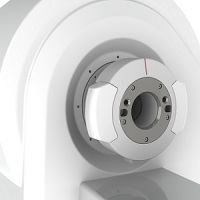Scientists from MIT have devised a new probe that enables them to image molecules in the brain without using any chemical or radioactive agents. The new probe consists of proteins and once it hits a particular target, the probe induces blood flow changes that can be seen by MRI or other imaging techniques. Their work is reported in the journal Nature Communications.
The current approach to imaging molecules in the brain is to tag them with radioactive probes. However, these probes deliver low resolution and they can't easily be used to watch dynamic events, explains Alan Jasanoff, an MIT professor of biological engineering.
To make their probes, Jasanoff and colleagues modified a naturally occurring peptide called calcitonin gene-related peptide (CGRP), which is active primarily during migraines or inflammation. They engineered the peptides so that they are trapped within a protein cage that keeps them from interacting with blood vessels.
In the study, the probes were used to detect enzymes called proteases, but the ultimate goal is to use them to monitor the activity of neurotransmitters, which act as chemical messengers between brain cells. When the peptides encountered proteases in the brain, the proteases cut the cages open and the CGRP caused nearby blood vessels to dilate. Imaging this dilation with MRI allowed the researchers to determine where the proteases were detected.
"This is an idea that enables us to detect molecules that are in the brain at biologically low levels, and to do that with these imaging agents or contrast agents that can ultimately be used in humans," says Jasanoff. "We can also turn them on and off, and that's really key to trying to detect dynamic processes in the brain."
Proteases can be used as biomarkers to diagnose diseases such as cancer and Alzheimer's disease. However, Jasanoff's lab used them in this study primarily to demonstrate the validity of their approach. Now, the MIT team is working on adapting these imaging agents to monitor neurotransmitters, such as dopamine and serotonin, that are critical to cognition and processing emotions. To do that, the team plans to modify the cages surrounding the CGRP so that they can be removed by interaction with a particular neurotransmitter.
The researchers hope to detect levels of neurotransmitter that are 100-fold lower than what have been detected so far. "We also want to be able to use far less of these molecular imaging agents in organisms. That's one of the key hurdles to trying to bring this approach into people," Jasanoff points out.
His lab is working on ways to deliver the peptides without injecting them, which would require finding a way to get them to pass through the blood-brain barrier. This barrier separates the brain from circulating blood and prevents large molecules from entering the brain.
Source: Massachusetts Institute of Technology
Image credit: The Researchers
References:
Desai M, Slusarczyk AL, Chapin A, Barch M, Jasanoff A (2016) Molecular imaging with engineered physiology. Nature Communications, 7:13607. doi: 10.1038/ncomms13607
Latest Articles
probe, image molecules, brain, MRI
Scientists from MIT have devised a new probe that enables them to image molecules in the brain without using any chemical or radioactive agents. The new probe consists of proteins and once it hits a particular target, the probe induces blood flow changes



























